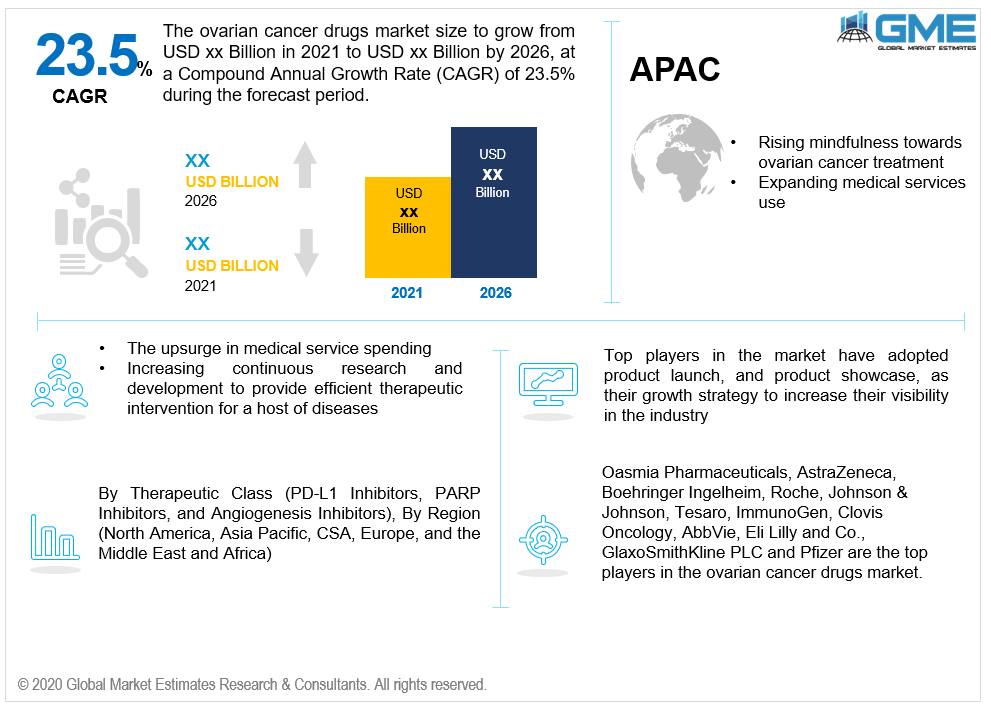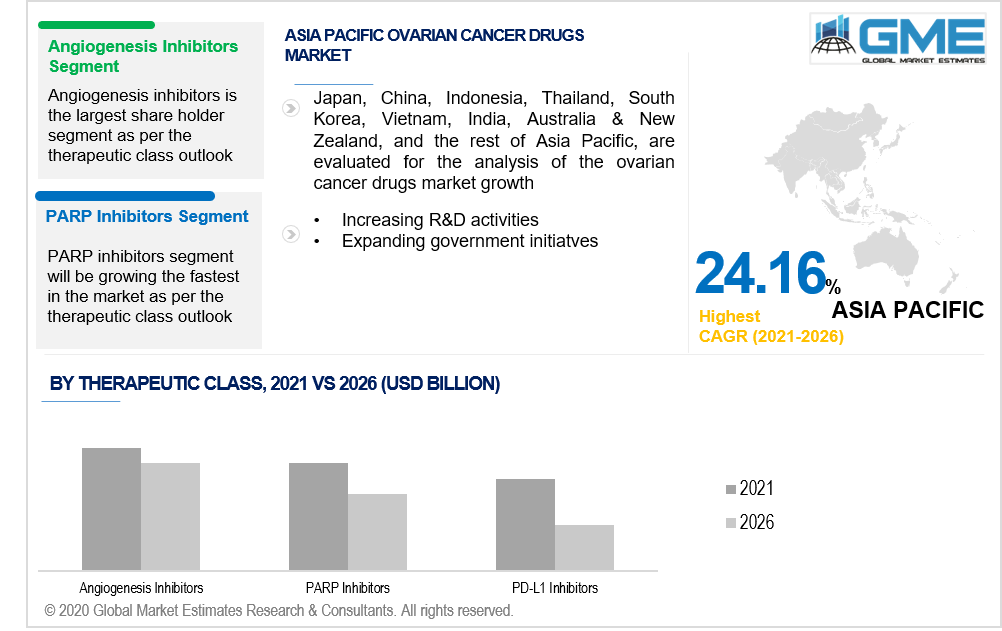
Global Ovarian Cancer Drugs Market Size, Trends & Analysis - Forecasts to 2026 By Therapeutic Class (PD-L1 Inhibitors, PARP Inhibitors, and Angiogenesis Inhibitors), Competitive Landscape, Company Market Share Analysis, and Competitor Analysis
Ovarian cancer is a term credited to the exceptional kind of disease that emerges in the ovary of a female from various sorts of cells. Ovarian cancer is triggered by mutagenesis modifications in the DNA. Acquired transformations in genes are likewise liable for ovarian cancer. If a female has BRCA1 or BRCA2 gene mutations, she is at an elevated risk of contracting ovarian cancer. The most well-known form of ovarian malignant development is epithelial ovarian cancer (EOC), which arises from the ovary's epithelium. Ovarian cancer is viewed as quite possibly the most well-known sort of disease among female demographics. It is responsible for more deaths than other cancers of the female reproductive system, and it ranks fifth in female deaths due to disease. This sort of cancer is once in a while analyzed at the beginning phase, making treatment at a high-level stage troublesome.
Ovarian cancer is one of the most common cancers in women, impacting mainly postmenopausal females. Bloating, pelvic or abdominal pain, nausea, upset stomach, back pain, and other signs of ovarian cancer are common. Although the exact cause of ovarian cancer is unclear, women over the age of 50 who have a family history of the disease are at a higher risk of developing it.
Ovarian cancer, and its rising prevalence level, is a global concern. Market participants who are actively working on the advancement of medications and chemotherapy drugs for the treatment of ovarian cancer are the core market drivers. The overall ovarian cancer drugs market is likely to be led by a significant volume of therapies in the development phase, as well as competitiveness amongst market players in respect of effectiveness and therapy expense. The patent expiration of many prominent drugs could also affect this market by attracting new entrants.
Through the projected period, these shifting trends would have a positive effect on the ovarian cancer market. The overall ovarian cancer drugs market has enormous prospects and is expected to expand exponentially. The ovarian cancer medicine market is growing as a result of ongoing research & development to enable effective clinical action for a variety of disorders. Numerous ovarian cancer treatments are currently in clinical trials and are projected to propel the market in the coming future. Merck, Pfizer, and Syndax Pharmaceuticals, Inc., for example, have reached a definitive deal to investigate two experimental drugs or medications for the diagnosis of ovarian cancer. The medications Avelumab and Entinostat were tested for effectiveness as a combined treatment for ovarian cancer in this research.
Moreover, many governments & non-government schemes for study & investment in ovarian cancer drugs therapeutics are projected to provide ample growth opportunities in the market in the upcoming years. The market drivers that are assisting in the further advancement are the developing event of ovarian cancer, advancements in malignancy treatments, the rise of the older female population, the ease of using new medications & treatments, the increase in medical services spending, and the increased government subsidizing. These trends are anticipated to help in the development of the ovarian cancer drug market.
Many notable pharma organizations in the ovarian cancer drugs market are contributing to the introduction of advanced products. For example, combined medications to diminish production costs, increased consistency & effectiveness, improved prescription concordance, increased productivity, and reduced side effects. Thus, creating skyrocketing demand in the ovarian cancer market.

Based on the therapeutic class, the market can be segregated into three types, namely PD-L1 Inhibitors, PARP Inhibitors and Angiogenesis Inhibitors. Angiogenesis Inhibitors is the market leader. Angiogenesis is important in cancer growth because solid tumours need a blood supply to develop above a few millimetres in size. Tumours can directly induce the formation of this bloodstream by emitting neurotransmitters that promote angiogenesis. Tumours may also activate normal cells in the vicinity to develop angiogenesis signalling agents. Since tumours cannot expand or propagate past a certain scale without blood flow, researchers have created angiogenesis inhibitors, which prevent tumour angiogenesis. The aim of these medications, also known as antiangiogenic agents, is to inhibit or delay the development of cancer by depriving it of the blood flow it requires.
In the ovarian cancer drug market, PARP inhibitors are predicted to be the fastest developing drug class. This drug class is expected to expand due to factors like continued adoption of licenced PARP inhibitors due to its excellent effectiveness, long therapy time, and a large number of possible treatments in first-line advanced settings.

As per the geographical analysis, the market of Ovarian Cancer Drugs can be classified into North America (the US, Canada, and Mexico), Asia Pacific (India, China, Japan, Malaysia, Singapore, and Rest of Asia Pacific), Europe (Germany, United Kingdom, Italy, France, Spain, Netherlands, and Rest of Europe), Middle East & Africa and Central & South America. North America is likely to hold its predominance in the global market. The variables that are adding to the market development incorporate the expanding pervasiveness of ovarian malignancy and grounded medical care foundation combined with the presence of significant market players in the region. Also, Asia-Pacific is assessed to display impressive market development in the global market. The rising mindfulness towards ovarian cancer treatment in growing economies, like China and India, alongside expanding medical service use are driving the market development. Due to the extreme rising prominence of ovarian cancer and favourable healthcare initiatives, Asia Pacific is expected to see substantial growth in the ovarian cancer drug market. Furthermore, the exclusion of limiting and social restriction, as well as the low-cost level, are likely to accelerate the development of the ovarian cancer drug market in the area.
Oasmia Pharmaceuticals, AstraZeneca, Boehringer Ingelheim, Roche, Johnson & Johnson, Tesaro, ImmunoGen, Clovis Oncology, AbbVie, Eli Lilly and Co., GlaxoSmithKline PLC and Pfizer are the top players in the ovarian cancer drugs market.
Please note: This is not an exhaustive list of companies profiled in the report.
Chapter 1 Methodology
1.1 Market Scope & Definitions
1.2 Estimates & Forecast Calculation
1.3 Historical Data Overview and Validation
1.4 Data Sources
1.4.1 Secondary
1.4.2 Primary
Chapter 2 Report Outlook
2.1 Ovarian Cancer Drugs Industry Overview, 2016-2026
2.1.1 Industry Overview
2.1.2 Therapeutic Class Overview
2.1.3 Regional Overview
Chapter 3 Ovarian Cancer Drugs Market Trends
3.1 Market Segmentation
3.2 Industry Background, 2016-2026
3.3 Market Key Trends
3.3.1 Positive Trends
3.3.1.1 Technology Advancement in Healthcare Industry
3.3.1.2 Increasing Expenditure on Healthcare
3.3.2 Industry Challenges
3.3.2.1 Limited Study and Industry Participants
3.4 Prospective Growth Scenario
3.4.1 Therapeutic Class Growth Scenario
3.5 COVID-19 Influence over Industry Growth
3.6 Porter’s Analysis
3.7 PESTEL Analysis
3.8 Value Chain & Supply Chain Analysis
3.9 Regulatory Framework
3.9.1 North America
3.9.2 Europe
3.9.3 APAC
3.9.4 LATAM
3.9.5 MEA
3.10 Technology Overview
3.11 Market Share Analysis, 2020
3.11.1 Company Positioning Overview, 2020
Chapter 4 Ovarian Cancer Drugs Market, By Therapeutic Class
4.1 Therapeutic Class Outlook
4.2 PD-L1 Inhibitors
4.2.1 Market Size, By Region, 2016-2026 (USD Million)
4.3 PARP Inhibitors
4.3.1 Market Size, By Region, 2016-2026 (USD Million)
4.4 Angiogenesis Inhibitors
4.4.1 Market Size, By Region, 2016-2026 (USD Million)
Chapter 5 Ovarian Cancer Drugs Market, By Region
5.1 Regional outlook
5.2 North America
5.2.1 Market Size, By Country 2016-2026 (USD Million)
5.2.2 Market Size, By Therapeutic Class, 2016-2026 (USD Million)
5.2.3 U.S.
7.2.3.1 Market Size, By Therapeutic Class, 2016-2026 (USD Million)
5.2.4 Canada
5.2.4.1 Market Size, By Therapeutic Class, 2016-2026 (USD Million)
5.3 Europe
5.3.1 Market Size, By Country 2016-2026 (USD Million)
5.3.2 Market Size, By Therapeutic Class, 2016-2026 (USD Million)
5.3.3 Germany
5.2.3.1 Market Size, By Therapeutic Class, 2016-2026 (USD Million)
5.3.4 UK
5.3.4.1 Market Size, By Therapeutic Class, 2016-2026 (USD Million)
5.3.5 France
5.3.5.1 Market Size, By Therapeutic Class, 2016-2026 (USD Million)
5.3.6 Italy
7.3.6.1 Market Size, By Therapeutic Class, 2016-2026 (USD Million)
5.3.7 Spain
5.3.7.1 Market Size, By Therapeutic Class, 2016-2026 (USD Million)
5.3.8 Russia
5.3.8.1 Market Size, By Therapeutic Class, 2016-2026 (USD Million)
5.4 Asia Pacific
5.4.1 Market Size, By Country 2016-2026 (USD Million)
5.4.2 Market Size, By Therapeutic Class, 2016-2026 (USD Million)
5.4.3 China
5.4.3.1 Market Size, By Therapeutic Class, 2016-2026 (USD Million)
5.4.4 India
5.4.4.1 Market Size, By Therapeutic Class, 2016-2026 (USD Million)
5.4.5 Japan
5.4.5.1 Market Size, By Therapeutic Class, 2016-2026 (USD Million)
5.4.6 Australia
5.4.6.1 Market Size, By Therapeutic Class, 2016-2026 (USD Million)
5.4.7 South Korea
5.4.7.1 Market Size, By Therapeutic Class, 2016-2026 (USD Million)
5.5 Latin America
5.5.1 Market Size, By Country 2016-2026 (USD Million)
5.5.2 Market Size, By Therapeutic Class, 2016-2026 (USD Million)
5.5.3 Brazil
5.5.3.1 Market Size, By Therapeutic Class, 2016-2026 (USD Million)
5.5.4 Mexico
5.5.4.1 Market Size, By Therapeutic Class, 2016-2026 (USD Million)
5.5.5 Argentina
5.5.5.1 Market Size, By Therapeutic Class, 2016-2026 (USD Million)
5.6 MEA
5.6.1 Market Size, By Country 2016-2026 (USD Million)
5.6.2 Market Size, By Therapeutic Class, 2016-2026 (USD Million)
5.6.3 Saudi Arabia
5.6.3.1 Market Size, By Therapeutic Class, 2016-2026 (USD Million)
5.6.4 UAE
5.6.5.1 Market Size, By Therapeutic Class, 2016-2026 (USD Million)
5.6.6 South Africa
5.6.6.1 Market Size, By Therapeutic Class, 2016-2026 (USD Million)
Chapter 6 Company Landscape
6.1 Competitive Analysis, 2020
6.2 Oasmia Pharmaceuticals
6.2.1 Company Overview
6.2.2 Financial Analysis
6.2.3 Strategic Positioning
6.2.4 Info Graphic Analysis
6.3 AstraZeneca
6.3.1 Company Overview
6.3.2 Financial Analysis
6.3.3 Strategic Positioning
6.3.4 Info Graphic Analysis
6.4 Boehringer Ingelheim
6.4.1 Company Overview
6.4.2 Financial Analysis
6.4.3 Strategic Positioning
6.4.4 Info Graphic Analysis
6.5 Roche
6.5.1 Company Overview
6.5.2 Financial Analysis
6.5.3 Strategic Positioning
6.5.4 Info Graphic Analysis
6.6 Johnson & Johnson
6.6.2 Financial Analysis
6.6.3 Strategic Positioning
6.6.4 Info Graphic Analysis
6.7 Tesaro
6.7.1 Company Overview
6.7.2 Financial Analysis
6.7.3 Strategic Positioning
6.7.4 Info Graphic Analysis
6.8 ImmunoGen
6.8.1 Company Overview
6.8.2 Financial Analysis
6.8.3 Strategic Positioning
6.8.4 Info Graphic Analysis
6.9 Clovis Oncology
6.9.1 Company Overview
6.9.2 Financial Analysis
6.9.3 Strategic Positioning
6.9.4 Info Graphic Analysis
6.10 AbbVie
6.10.2 Financial Analysis
6.10.3 Strategic Positioning
6.10.4 Info Graphic Analysis
6.11 Eli Lilly and Co.
6.11.1 Company Overview
6.11.2 Financial Analysis
6.11.3 Strategic Positioning
6.11.4 Info Graphic Analysis
6.12 GlaxoSmithKline PLC
6.12.2 Financial Analysis
6.12.3 Strategic Positioning
6.12.4 Info Graphic Analysis
6.13 Pfizer
6.13.1 Company Overview
6.13.2 Financial Analysis
6.13.3 Strategic Positioning
6.13.4 Info Graphic Analysis
6.14 Other Companies
6.14.1 Company Overview
6.14.2 Financial Analysis
6.14.3 Strategic Positioning
6.14.4 Info Graphic Analysis
The Global Ovarian Cancer Drugs Market has been studied from the year 2019 till 2026. However, the CAGR provided in the report is from the year 2021 to 2026. The research methodology involved three stages: Desk research, Primary research, and Analysis & Output from the entire research process.

The desk research involved a robust background study which meant referring to paid and unpaid databases to understand the market dynamics; mapping contracts from press releases; identifying the key players in the market, studying their product portfolio, competition level, annual reports/SEC filings & investor presentations; and learning the demand and supply-side analysis for the Ovarian Cancer Drugs Market.

The primary research activity included telephonic conversations with more than 50 tier 1 industry consultants, distributors, and end-use product manufacturers.

Finally, based on the above thorough research process, an in-depth analysis was carried out considering the following aspects: market attractiveness, current & future market trends, market share analysis, SWOT analysis of the company and customer analytics.

Tailor made solutions just for you
80% of our clients seek made-to-order reports. How do you want us to tailor yours?
OUR CLIENTS